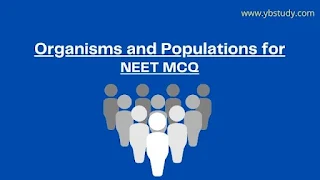Organisms and Populations NEET Questions:
Candidates who wish to prepare for the NCERT board exam and for the NEET exam can prepare better using our MCQ Questions for Class 11 Biology Chapter 13 Organisms and populations with Answers. From here candidates can download Organisms and populations NEET questions in Pdf format. These will help aspirants to be familiar with a NEET examination. Along with that, due to the regular practice of these MCQ questions, candidates will get to know their strengths and weak topics in the Organisms and populations Chapter.
Organisms and Populations MCQ for NEET:
1. Increase of population under optimum condition is termed.
(1) Reproductive ability
(2) Secondary production
(3) Biotic potential
(4) Biomass
Answer: (3) Biotic potential
Read: Reproduction in Organisms NEET MCQs
2. In a population, unrestricted reproductive capacity is called as________________________
(1) Biotic potential
(2) Fertility
(3) Carrying capacity
(4) Birth rate
Answer: (1) Biotic potential
Read: Sexual Reproduction in Flowering Plants NEET MCQs
3. In plant succession last community is called _____________________
(1) Ecotone
(2) Climax community
(3) Seral community
(4) Ecosystem
Answer: (2) Climax community
Read: Human Reproduction NEET MCQs
4. Mycorrhizae relationship between fungi and roots of higher plants is___________________
(1) Parasitic relationship
(2) Saprophytic relationship
(3) Symbiotic relationship
(4) Epiphytic relationship
Answer: (3) Symbiotic relationship
Read: Principles of Inheritance and Variation MCQs for NEET
5. The group of organisms of different species forms a___________________
(1) Community
(2) Population
(3) Ecosystem
(4) Biome
Answer: (1) Community
Read: Molecular Basis of Inheritance MCQs for NEET
6. In an ecosystem, the function of the producers is to___________________
(1) Convert organic compounds into inorganic compounds
(2) Trap solar energy and convert it into chemical energy
(3) Utilize chemical energy
(4) Release energy
Answer: (2) Trap solar energy and convert it into chemical energy
Read: Biotechnology and its Applications MCQs
7. Which factor of an ecosystem includes plants, animals, and microorganisms?
(1) Biotic factor
(2) Abiotic factor
(3) Direct factor
(4) Indirect factor
Answer : (1) Biotic factors
8. Association between sea anemone and Hermit crab in gastropod shell is that of................
(1)Mutualism
(2)Commensalism
(3) Parasitism
(4) Amensalism
Answer : (2) Commensalism
9. Growth of bacteria in a newly inoculated agar plate shows................
(1) exponential growth
(2) logistic growth
(3) Verhulst-Pearl logistic growth
(4) zero growth
Answer : (4) Zero Growth
10. One of the following is associated with the conservation of forests.
(1) Kaziranga
(2) Ghana
(3) Silent valley
(4) Gir
Answer: (3) Silent valley
11. The method by which endangered plant species are conserved in a botanical garden or in some controlled circumstances -
(1) Afforestation
(2) In situ conservation
(3) Ex-situ conservation
(4) None of the above
Answer: (3) Ex-situ conservation
12. Which one of the following is the correctly matched pair of an endangered animal and a National Park?
(1) Wild ass — Dudhwa National Park
(2) Great Indian — Keoladeo National Park
Bustard
(3) Lion— Corbett National Park
(4) Rhinoceros — Kaziranga National Park
Answer: (4) Rhinoceros — Kaziranga National Park
13. Which one of the following has the highest number of species in nature?
(1) Fungi
(2) Insects
(3) Birds
(4) Angiosperms
Answer: (2) Insects
14. According to the Central Pollution Control Board (CPCB), which particulate size in diameter (in micrometers) of the air pollutants is responsible for the greatest harm to human health?
(1) 1.0 or less
(2) 5.2 – 2.5
(3) 2.5 or less
(4) 1.5 or less
Answers: (3) 2.5 or less
15. Eutrophication of water body leads to death of aquatic fishes due to decline in___________
(1) Oxygen
(2) Nutrients and minerals
(3) Light
(4) Food
Answer: (1) Oxygen
16. Which one of the following population interactions is widely used in medical science for the production of antibiotics?
(1) Commensalism
(2) Mutualism
(3) Parasitism
(4) Amensalism
Answer: (4) Amensalism
17. An orchid plant growing on the branch of a mango tree, what is the interaction between orchid & mango?
(1) Parasitism
(2) Commensalism
(3) Protocoperation
(4) Mutualism
Answer: (2) Commensalism
18. Select the statement which best explains commensalism.
(1) One organism is benefited
(2) Both the organisms are benefited
(3) One organism is benefitted, other is not affected
(4) One organism is benefitted, other is affected
Answer: (3) One organism is benefitted, other is not affected
19. Antifreeze proteins or AFPs enable organisms that possess them to____________
(1) Survive high temperatures
(2) Survive extreme pressure
(3) Survive subzero temperatures
(4) None of the above
Answer: (3) Survive subzero temperatures
20. Which of the following is an example of Mycorrhiza
(1) ectoparasitism
(2) mutualism
(3) endoparasitism
(4) predation
Answer: (2) mutualism
21. Xerophytes generally do not possess ________
(1)A thick cuticle
(2)Spongy Parenchyma
(3) Specialized mechanical tissue
(4) Well developed conducting tissue
Answer: (2) Spongy Parenchyma
